Transform your outdoor space into a stunning showcase of Australia’s natural beauty. We’ve discovered that native gardens aren’t just environmentally friendly – they’re incredibly diverse and surprisingly low-maintenance once established. From vibrant bottlebrush blooms to elegant eucalyptus canopies these indigenous plants create breathtaking landscapes that thrive in local conditions.
Australian native gardens offer year-round color texture and wildlife habitat while dramatically reducing water bills and maintenance time. We’ll show you how drought-tolerant natives like kangaroo paw grevilleas and wattles can create stunning focal points that attract native birds and beneficial insects to your yard.
Whether you’re working with a small courtyard or sprawling acreage we’ve got design ideas that’ll make your neighbors envious. Our carefully curated native garden concepts blend traditional Aboriginal plant knowledge with modern landscaping techniques to create spaces that are both culturally important and visually spectacular.
Create a Water-Wise Foundation With Native Grasses
Native grasses form the backbone of sustainable Australian gardens that thrive without constant irrigation. These resilient plants create stunning landscapes while supporting local ecosystems and reducing maintenance demands.
Select Drought-Tolerant Varieties Like Kangaroo Grass
Kangaroo grass stands out as Australia’s most adaptable native grass species for water wise gardens. This hardy perennial grows 2-3 feet tall and produces delicate seed heads that dance in the breeze while requiring minimal water once established. We recommend planting kangaroo grass in clusters of 5-7 plants to create natural drifts that mimic wild grassland patterns.
Wallaby grass offers another excellent choice for creating textural contrast in native plantings. Growing up to 18 inches high, this fine-leafed grass develops attractive bronze tones during autumn months. Weeping grass adds movement to garden beds with its graceful arching stems that reach 4 feet in height.
Spear grass provides vertical interest with its distinctive upright growth habit and silvery blue foliage. This species tolerates extreme drought conditions and produces attractive flowering spikes in late summer. Poa grass varieties work well as transition plants between larger specimens, forming neat tufts that require water only during establishment periods.
Design Natural Pathways Using Ornamental Natives
Ornamental native grasses create beautiful informal pathways that guide visitors through garden spaces naturally. We plant low-growing varieties like mat rush along pathway edges to define walking areas without rigid borders. These plants form dense mats 6-12 inches high that withstand foot traffic while maintaining their attractive appearance.
Lomandra species work exceptionally well for pathway design because they tolerate partial shade and foot traffic. Blue flax lily provides colorful accent points along walkways with its bright blue flowers and strappy foliage. Dianella varieties offer similar benefits while producing attractive berries that feed native birds.
Sedge grasses create soft transitions between pathways and garden beds through their naturally arching growth patterns. We space these plants 18-24 inches apart to allow for mature spread while maintaining pathway definition. Tufted grass varieties establish clear sight lines through garden areas while preserving the natural, unstructured feel that characterizes Australian landscapes.
Establish Ground Cover for Erosion Control
Ground covering native grasses prevent soil erosion while creating living carpets that suppress weed growth effectively. Microlaena stipoides forms dense mats that stabilize slopes and banks through extensive root systems that bind soil particles together. This species spreads naturally through underground runners, establishing complete coverage within two growing seasons.
Native violet provides excellent erosion control on gentle slopes while producing attractive purple flowers throughout spring months. We plant these species at 12-inch intervals on slopes exceeding 15 degrees to ensure rapid establishment and soil stabilization. Creeping saltbush works well in coastal areas where salt spray and sandy soils present challenges for other ground covers.
Pigface offers dual benefits as both erosion control and edible landscaping, producing succulent leaves and colorful flowers while spreading across difficult terrain. Buffalo grass creates durable living surfaces in high traffic areas while requiring 70% less water than traditional lawn alternatives. These native ground covers establish deep root systems that access moisture from lower soil levels, reducing irrigation needs significantly once mature.
Design Stunning Focal Points With Native Trees
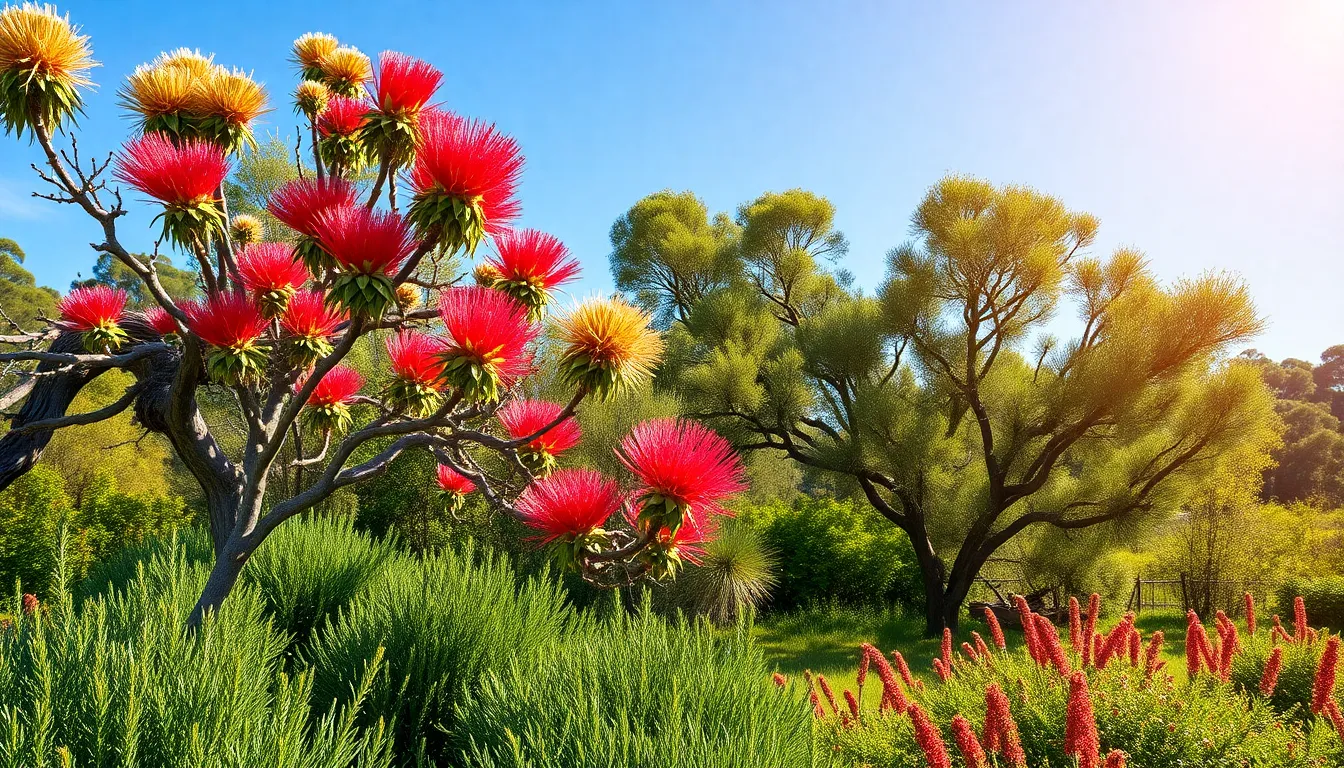
Creating dramatic focal points transforms ordinary gardens into breathtaking landscapes that celebrate Australia’s natural heritage. We’ll explore how native trees can serve as stunning centerpieces that anchor your garden design.
Choose Eucalyptus Species for Height and Structure
Eucalyptus trees offer unmatched versatility with over 700 species available for different climates and garden designs. These magnificent natives provide essential height and structure that creates visual hierarchy in your industry. Selecting the right eucalyptus variety depends on your exact growing conditions and desired aesthetic impact.
Smaller gardens benefit from compact species like lemon scented gum or silver dollar eucalyptus that won’t overwhelm the space. Larger properties can accommodate towering varieties such as river red gum or forest red gum that create impressive canopy coverage. Consider the mature size carefully since eucalyptus trees grow rapidly and can dominate surrounding plantings if not properly planned.
Incorporate Flowering Natives Like Bottlebrush
Bottlebrush trees deliver vibrant red flowers that create stunning visual impact while attracting essential pollinators to your garden. These hardy natives bloom prolifically throughout spring and summer, providing consistent color when many other plants remain dormant. Callistemon species thrive in various soil conditions and require minimal maintenance once established.
Position bottlebrush trees strategically near outdoor living areas where their brilliant blooms create natural conversation pieces. Their cylindrical flowers also work beautifully as cut arrangements, bringing garden beauty indoors. Multiple varieties offer different flower colors including pink, white, and yellow options that complement diverse garden palettes.
Plan for Seasonal Color Changes
Wattle trees provide spectacular spring displays with vibrant yellow flowers that signal the changing seasons across Australia. With over 800 acacia species available, we can select varieties that bloom at different times throughout the year for extended seasonal interest. These fast growing natives adapt to various soil types and climate conditions.
Timing your plantings ensures continuous color rotation as different native trees reach peak flowering periods. Early bloomers like golden mimosa start the display in late winter, while later varieties extend the show through summer months. This strategic planning creates ever-changing gardens that evolve throughout the year rather than remaining static.
Build Layered Plantings With Native Shrubs
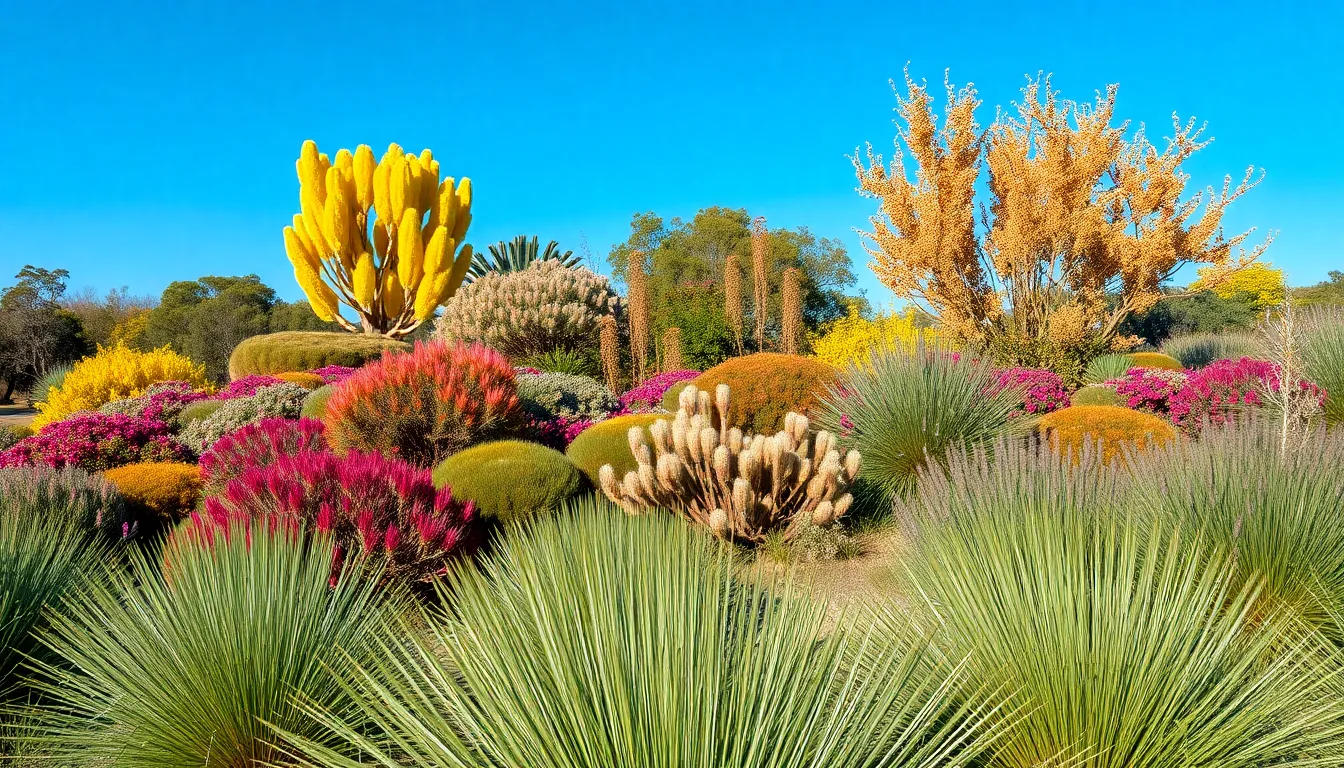
Layered plantings create depth and visual drama by combining native shrubs at different heights throughout your garden space. We can achieve stunning results by positioning taller Grevilleas and Banksias as backdrop plants while incorporating lower growing Lomandra longifolia grasses in the foreground.
Select Low Maintenance Varieties for Borders
Border plantings require hardy species that’ll thrive with minimal intervention and water requirements. Wattles establish quickly along property edges and provide golden blooms without demanding constant attention from busy gardeners. Eucalyptus varieties offer silvery foliage that creates attractive boundaries while tolerating drought conditions and poor soils naturally.
These resilient natives adapt to various environmental conditions and continue flourishing even when we can’t provide regular care. Choosing drought resistant species means spending less time watering and more time enjoying our outdoor spaces.
Create Privacy Screens Using Dense Natives
Dense growing native plants form effective privacy barriers while supporting local wildlife populations simultaneously. Tuckeroo trees (Cupaniopsis anacardioides) develop thick canopies that block sightlines from neighboring properties and busy streets. Coast Banksias (Banksia integrifolia) grow into substantial screening plants that provide year round coverage and attract native birds.
Strategic placement of these screening plants creates secluded garden rooms where we can relax without feeling exposed. Their dense growth patterns eliminate the need for artificial fencing materials while adding natural beauty to our property borders.
Mix Textures for Visual Interest
Combining contrasting plant textures transforms ordinary garden beds into visually captivating landscapes that engage multiple senses. Smooth Kentia palm fronds create elegant contrast against the rough, papery bark of mature Eucalyptus trees. Soft, flowing Lomandra grass foliage provides textural balance when planted alongside architectural succulents and spiky native plants.
Textural variety prevents monotonous planting schemes and adds sophisticated design elements that change with seasonal growth patterns. We can layer smooth, rough, fine, and bold textures to create gardens that remain interesting throughout the year.
Attract Wildlife With Native Flowering Plants

Creating a wildlife-friendly native garden transforms our outdoor spaces into thriving ecosystems that support local biodiversity. We can establish habitats that attract birds, bees, and small animals by selecting the right combination of flowering plants.
Plant Nectar-Rich Species for Birds and Bees
Banksias serve as powerhouse nectar sources that draw both native birds and beneficial insects throughout the year. These spectacular flowering plants produce abundant nectar-rich blooms that honeyeaters, lorikeets, and native bees depend on for sustenance. We should incorporate Grevilleas alongside Banksias to create a diverse feeding station that attracts different pollinator species with their unique flower shapes and blooming schedules.
Strategic placement of these nectar producers ensures continuous food sources across seasons. Mixing early and late flowering varieties provides sustained nutrition for wildlife populations when natural food sources become scarce. We can maximize pollinator support by grouping multiple nectar-rich plants together, creating concentrated feeding zones that birds and bees visit regularly.
Include Seed-Producing Plants for Small Animals
Wattles produce protein-rich seeds that native birds like finches and parrots rely on for their nutritional needs. These hardy plants develop seed pods that provide essential food sources for small mammals and ground-dwelling birds throughout autumn and winter months. We should plant various Eucalyptus species that produce different sized seeds, catering to the diverse dietary requirements of our local wildlife.
Finger Limes offer dual benefits by producing seeds that attract small animals while providing unique citrus fruits for our own use. These native plants support local ecosystems by creating sustainable food chains that benefit multiple species simultaneously. We can establish seed-producing zones in quieter garden areas where wildlife feels safe to forage and feed.
Create Habitat Zones for Local Wildlife
Designing garden zones that mimic natural Australian habitats encourages wildlife to establish permanent residence in our outdoor spaces. We should incorporate native grasses alongside flowering plants to create layered environments that provide both shelter and food sources. These diverse plantings offer nesting sites for small birds while attracting the insects that many wildlife species depend on.
Specialist nurseries like Harvest Seeds & Native Plants in Terrey Hills, NSW, provide expert guidance for selecting region-exact native plants that create effective wildlife habitats. Establishing variety in plant heights and densities gives different animal species the shelter options they need to thrive. We can create wildlife corridors by connecting habitat zones throughout our gardens, allowing animals to move safely between feeding and nesting areas.
Incorporate Natural Stone and Native Materials
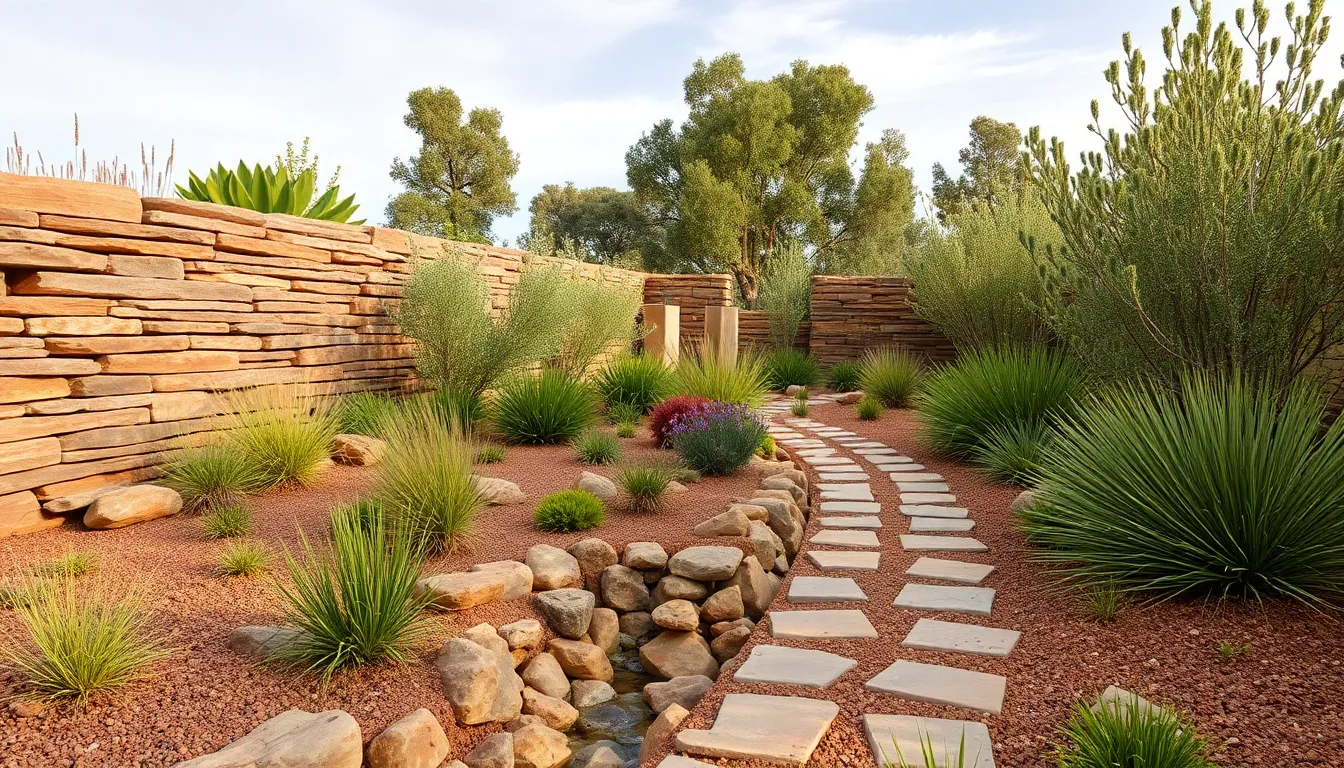
Natural stone and indigenous materials create authentic Australian landscapes while supporting local ecosystems. We’ll explore practical ways to integrate these elements into your native garden design.
Use Local Rock for Retaining Walls and Features
Local rock transforms sloping properties into stunning terraced gardens that mirror Australia’s natural industry. We can construct retaining walls using sandstone, limestone, or granite sourced from regional quarries to create authentic visual connections with the surrounding environment. These structures provide essential soil stabilization while showcasing the geological character of your area.
Native rock features serve multiple functional purposes beyond their aesthetic appeal. Retaining walls help manage water runoff during heavy rainfall seasons while creating distinct planting zones for different native species. Large boulders strategically placed throughout the garden become natural focal points that complement native trees like bottlebrush and eucalyptus.
Building with local materials reduces transportation costs and environmental impact compared to imported alternatives. We recommend selecting stones that weather naturally in your climate zone to ensure long term durability and visual harmony with existing industry features.
Design Dry Creek Beds With Indigenous Stones
Indigenous stones create realistic dry creek beds that capture Australia’s unique water patterns and seasonal variations. We can design these features using river stones, weathered granite, and native pebbles to mimic natural watercourses found throughout Australian landscapes. These installations provide excellent drainage answers while adding textural interest to flat garden areas.
Dry creek beds function as natural stormwater management systems during Australia’s unpredictable weather patterns. Water runoff follows these constructed channels during heavy rainfall, preventing soil erosion while directing moisture toward planted areas. Native grasses like kangaroo grass and wallaby grass thrive along these stone lined pathways.
Varying stone sizes throughout the creek bed creates authentic visual depth and movement. We suggest combining larger foundation rocks with smaller decorative stones to replicate the natural sorting patterns found in real Australian creek systems.
Build Pathways Using Sustainable Materials
Sustainable pathway materials connect garden areas while minimizing environmental impact through responsible sourcing and waste reduction. We can construct walkways using recycled natural stone, locally sourced gravel, or mulched native wood from sustainable forestry operations. These materials blend seamlessly with native plantings while providing durable foot traffic surfaces.
Recycled stone pathways offer excellent longevity while diverting materials from landfill waste streams. Crushed sandstone or decomposed granite creates permeable surfaces that allow rainwater infiltration while suppressing weed growth between planted areas. Native wood mulch from eucalyptus or wattle trees provides soft walking surfaces that naturally decompose and enrich soil over time.
Strategic pathway placement guides visitors through your native garden while protecting sensitive plant root systems from foot traffic damage. We recommend incorporating stepping stones or timber rounds to create natural pauses where people can observe wildlife attractions like native birds feeding on Grevillea nectar or small animals sheltering among dense native shrubs.
Establish Low-Maintenance Garden Zones
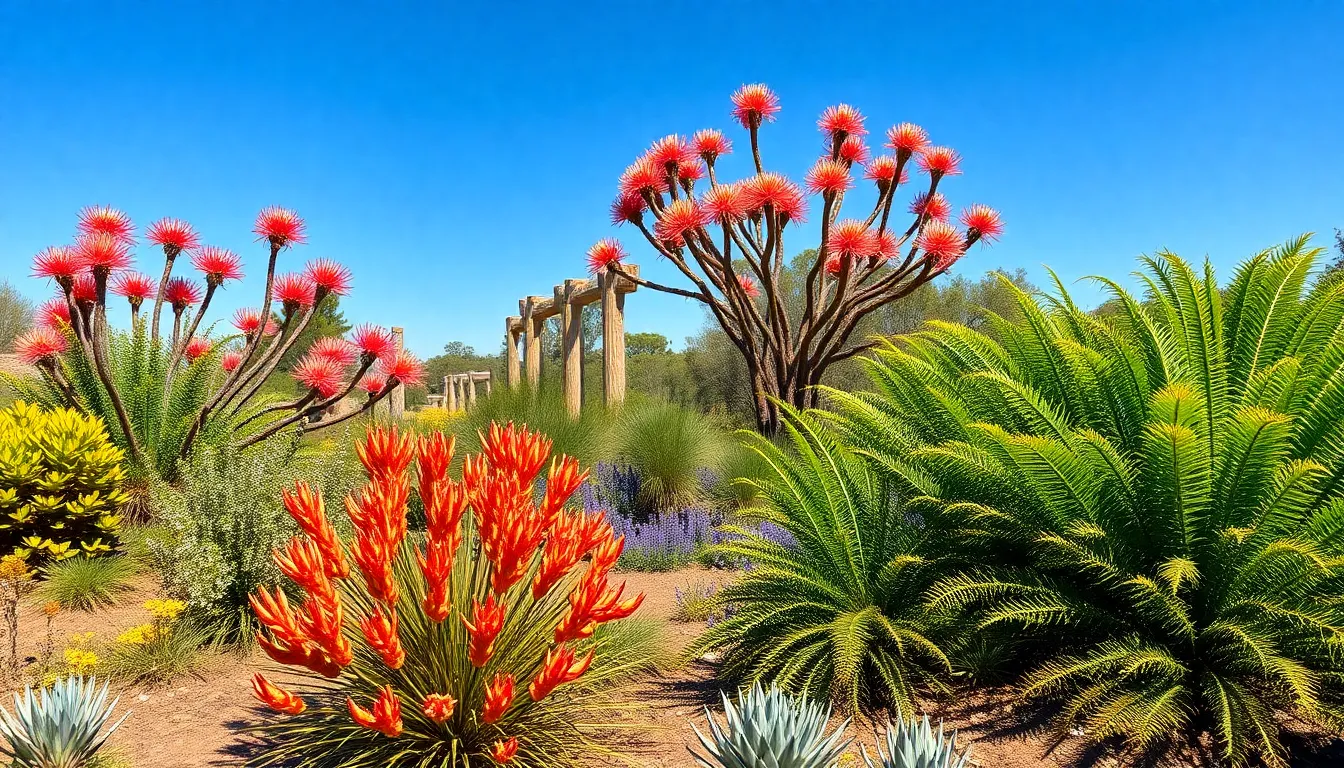
Building low maintenance garden zones with Australian natives reduces our gardening workload while creating beautiful, sustainable landscapes. These hardy plants adapt naturally to local conditions and thrive with minimal intervention.
Group Plants by Water Requirements
Organizing plants according to their hydration needs creates efficient watering zones that conserve water and promote healthier growth. We recommend placing drought tolerant species like Grevilleas together in areas that receive less irrigation, while grouping moisture loving plants such as native ferns in shadier, more humid sections of our garden.
Different native species have varying water demands throughout the year. Finger Limes require consistent moisture during fruit development, whereas Wollemi Pines adapt well to seasonal rainfall patterns without supplemental watering. Clustering plants with similar needs allows us to customize irrigation schedules and reduce water waste significantly.
Strategic grouping also prevents overwatering sensitive species that prefer drier conditions. Eucalyptus varieties typically flourish in well drained soils with minimal water, making them perfect companions for other drought resistant natives like wattles and native grasses.
Create Self-Sustaining Ecosystems
Developing interconnected plant communities that support each other naturally reduces our maintenance requirements while improving biodiversity. We can establish these ecosystems by combining native plants that attract beneficial insects, birds, and other wildlife that contribute to natural pest control and pollination.
Self sustaining gardens rely on natural processes rather than external inputs like fertilizers and pesticides. Native plants develop symbiotic relationships with local soil microorganisms, improving soil health and nutrient cycling without chemical amendments. These relationships strengthen over time, creating increasingly resilient garden zones.
Wildlife corridors within our native gardens support natural regeneration and seed dispersal. Birds and small animals transport seeds between planted areas, encouraging new growth and filling gaps naturally. This process creates diverse plant communities that mirror natural Australian landscapes.
Companion planting with natives also provides natural mulch through leaf drop and organic matter decomposition. This continuous cycle enriches soil structure and retains moisture, reducing our need for external mulching and fertilizing.
Minimize Lawn Areas With Native Alternatives
Replacing traditional turf with native groundcovers dramatically reduces water consumption and maintenance time while creating more authentic Australian landscapes. Lomandra longifolia serves as an excellent lawn substitute, forming dense, attractive coverage that requires minimal mowing and watering compared to exotic grasses.
Native grass alternatives like Microlaena stipoides provide soft, walkable surfaces that handle foot traffic while suppressing weeds naturally. These indigenous options establish deep root systems that prevent soil erosion and require significantly less water than conventional lawns.
We can create functional outdoor spaces using native groundcovers that serve multiple purposes. Native violets spread quickly to form colorful carpets perfect for areas where we want visual interest without high maintenance, while hardy native sedges work well in transition zones between garden beds.
Textured groundcover combinations add visual depth while eliminating the need for regular lawn care routines. Mixing different native species creates natural patterns and seasonal color changes that keep our landscapes interesting throughout the year without constant upkeep.
Plan Seasonal Interest Throughout the Year

Creating year round visual appeal requires strategic plant selection that ensures something beautiful is always happening in your native garden. We’ll explore how different Australian natives can provide continuous seasonal interest through blooming cycles, foliage colors, and structural elements.
Select Plants for Continuous Blooming Cycles
Grevillea leucopteris and Grevillea petrophiloides offer exceptional year round flowering interest with their tall, leggy canes that produce blooms in rotating cycles. These hardy natives ensure you’ll always have nectar sources for local birds and colorful displays throughout every season.
Wattles bloom spectacularly in early spring, creating golden cascades that signal the start of the growing season. Their timing perfectly complements other natives like Finger Limes, which provide bursts of citrus flavor and vibrant color throughout multiple seasons.
Kangaroo Paw flowers create stunning displays from late spring through early fall, bridging the gap between spring bloomers and autumn performers. We recommend planting these alongside continuous bloomers to maintain consistent color rotation across your garden beds.
Staggered planting of different native species ensures you’ll have overlapping bloom periods rather than gaps between flowering cycles. This approach creates the visual continuity that makes Australian native gardens so appealing year round.
Include Natives With Colorful Foliage
Eucalyptus species offer an incredible range of foliage colors and textures that provide interest even when plants aren’t blooming. Different varieties showcase silver, blue green, red, and bronze tones that change subtly with seasons and growing conditions.
Lomandra longifolia provides robust, grass like appearance with subtle color variations that shift from deep green to golden tones throughout the year. This versatile native works beautifully as a foundation plant that supports more dramatic seasonal performers.
Seasonal foliage changes in natives like certain Eucalyptus species create natural autumn displays without requiring exotic plants. These color shifts happen gradually, providing sustained visual interest rather than brief moments of beauty.
Textural variety in native foliage adds depth to your garden design while maintaining the authentic Australian character. Combining fine, needle like leaves with broad, waxy foliage creates compelling contrasts that remain attractive in every season.
Design for Winter Structure and Form
Banksia trees retain their distinctive cones throughout winter months, adding sculptural elements when many other plants are dormant. These architectural features provide focal points and maintain garden interest during the quieter winter season.
Tree Ferns create lush, green backdrops year round, offering consistent structure that anchors your garden design through seasonal changes. Their prehistoric appearance adds drama while requiring minimal maintenance once established.
Wollemi Pines in pots serve as moveable sculptural elements that can be repositioned to create winter focal points where needed most. These living fossils provide unique architectural interest that works beautifully with other native structural plants.
Winter garden bones become most apparent when deciduous elements are bare, making the selection of evergreen natives crucial for maintaining visual appeal. Strong structural plants ensure your garden remains attractive and purposeful throughout the coldest months.
Integrate Practical Elements With Native Plantings
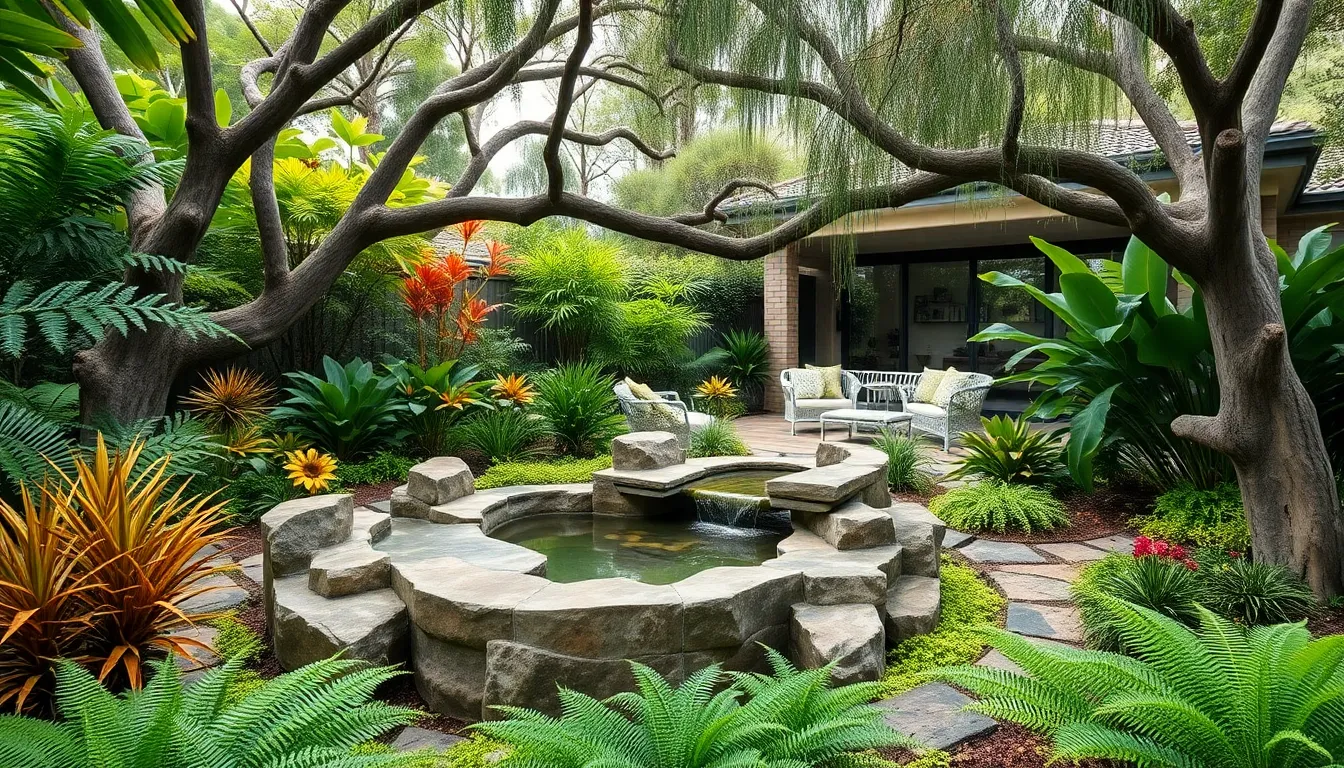
Combining functional design elements with indigenous flora creates gardens that serve multiple purposes while celebrating Australia’s natural heritage. We can transform our outdoor spaces into practical yet beautiful landscapes that work harmoniously with native ecosystems.
Design Outdoor Living Spaces Among Natives
Natural privacy screens emerge when we strategically place native foliage like Lomandra longifolia grasses and Banksia integrifolia around seating areas. These hardy plants create intimate spaces without sacrificing the wild beauty that makes Australian gardens so distinctive.
Established trees provide essential shade while framing our outdoor living spaces with organic architecture. We’ll find that positioning furniture beneath mature canopies creates comfortable zones that feel naturally integrated rather than imposed upon the industry.
Creating defined pathways through native plantings helps organize outdoor areas while maintaining visual flow. Dense groundcovers like native violet guide movement through the garden while suppressing weeds and stabilizing soil naturally.
Create Productive Areas With Edible Natives
Finger Limes bring zesty pearls and productive functionality to our native garden designs. These unique citrus relatives thrive in Australian conditions while offering gourmet ingredients that elevate home cooking with distinctly local flavors.
Native herbs transform practical garden areas into culinary resources that connect us to traditional Aboriginal plant knowledge. Plants like native mint, saltbush, and lemon myrtle provide cooking ingredients while requiring minimal maintenance compared to exotic herb varieties.
Positioning edible natives alongside ornamental species creates seamless integration between beauty and function. We can scatter productive plants throughout the industry rather than confining them to separate vegetable patches that might look out of place.
Install Water Features Using Natural Materials
Tranquil ponds constructed with fallen tree fern trunks provide habitat for native ferns while creating serene focal points. These natural materials weather beautifully and support the growth of indigenous moisture loving plants that would naturally occur near water sources.
Natural stone features blend seamlessly with surrounding native plantings while managing water flow throughout the garden. Local rocks and boulders create authentic landscapes that support proper drainage while providing shelter for small wildlife.
Incorporating indigenous materials into water features ensures our installations age gracefully within the native network. Weathered wood, local stone, and naturally occurring materials create water elements that feel like they’ve always belonged in the Australian industry.
Conclusion
Creating an Australian native garden transforms our outdoor spaces into thriving ecosystems that celebrate the continent’s unique flora. We’ve explored how indigenous plants offer unmatched benefits – from reduced maintenance and water requirements to supporting local wildlife and providing year-round visual appeal.
By thoughtfully combining native trees shrubs grasses and groundcovers we can design landscapes that evolve naturally through the seasons. These gardens don’t just look stunning – they actively contribute to biodiversity while requiring minimal intervention once established.
Whether we’re working with compact urban spaces or expansive properties the principles remain the same: choose plants suited to our local conditions group them by water needs and create habitat zones that support native wildlife. The integration of natural materials and practical elements ensures our gardens serve both aesthetic and functional purposes.
Australian native gardens represent more than landscaping choices – they’re investments in sustainable living that honor our natural heritage while creating beautiful meaningful outdoor spaces for generations to enjoy.
Frequently Asked Questions
What are the main benefits of creating an Australian native garden?
Australian native gardens offer numerous advantages including reduced water bills, minimal maintenance requirements, and year-round color and texture. They provide essential wildlife habitats for local birds and beneficial insects while thriving in local climate conditions. Native plants are naturally drought-tolerant and require less fertilizer, making them environmentally sustainable and cost-effective for homeowners.
Which native plants are best for low-maintenance landscaping?
Excellent low-maintenance native options include eucalyptus varieties, bottlebrush trees, wattles, Grevilleas, and Banksias. For ground cover, consider kangaroo grass, wallaby grass, Microlaena stipoides, and native violet. These plants are naturally adapted to Australian conditions, requiring minimal watering, pruning, and fertilization once established in appropriate locations.
How can I create privacy screens using native plants?
Dense native plants like Tuckeroo, Coast Banksias, Lomandra longifolia, and Banksia integrifolia create effective natural privacy barriers. These species grow thick foliage that provides excellent screening while supporting local wildlife. Plant them in clusters or rows, ensuring adequate spacing for mature growth while maintaining dense coverage for optimal privacy.
What native grasses work best for erosion control?
Kangaroo grass, wallaby grass, and weeping grass are excellent choices for preventing soil erosion on slopes and unstable areas. Microlaena stipoides is particularly effective for ground stabilization, while native violet provides attractive low-growing coverage. These grasses develop strong root systems that bind soil effectively while requiring minimal maintenance once established.
How do I plan for year-round color in my native garden?
Select plants with staggered blooming cycles like Grevillea leucopteris, kangaroo paw, and various wattle species for continuous flowers. Incorporate natives with colorful foliage such as different eucalyptus varieties that provide visual interest beyond blooming periods. Add structural elements like Banksia trees and Tree Ferns to maintain winter appeal and create focal points.
Can I incorporate edible native plants into my landscape design?
Yes, edible natives like Finger Limes, native herbs, and bush tucker plants can seamlessly blend culinary function with aesthetic appeal. These plants provide unique flavors while maintaining the authentic Australian garden theme. Consider placement near outdoor dining areas or kitchen gardens where they’re easily accessible for harvesting and culinary use.
How do I create wildlife-friendly zones in my native garden?
Plant nectar-rich species like Banksias and Grevilleas to attract birds and beneficial insects throughout different seasons. Include seed-producing plants such as wattles and eucalyptus for small animals and birds. Design habitat zones with varying plant heights and densities that mimic natural Australian environments, creating shelter and food sources for local wildlife.
What materials should I use for pathways and garden features?
Use sustainable materials like recycled stone, native wood, and local rocks for authentic Australian landscapes. Create pathways with indigenous stones and build retaining walls with local rock for soil stabilization. Design dry creek beds using native stones for natural stormwater management while maintaining visual appeal and environmental sustainability.







